Intel, or the Intel Corporation, was founded a year earlier in 1968. Both companies were incorporated in Valley in the USA, and are leaders in research and development in the field. These multinational companies are also well known for developing production facilities in Asia, such as in Taiwan, China, Malaysia, and Singapore. Nevertheless, it is said their products are in use in every country where PCs are used.
Both AMD and Intel produce mother boards which are the circuitry at the base of all personal computers. AMD and Intel also create CPU or Central Processing Unit chips for the personal computer. While both are in the same industry but are always vying against each other for marketshare and technological changes.
You can compare AMD and Intel processors on Diffen.
Comparison chart
AMD
Intel
Video Graphics Performance
2015 VGA Charts
Our brand new 2015 VGA charts are designed to do justice to graphics cards between mainstream and the highest end. We will therefore cover entry-level graphics solutions in a different charts set, as comparing these to high-end card makes limited sense. We run as many as 10 selected benchmarks at resolutions of 1920x1080 (Full HD) as well as 3840x2160 (UHD). Both are run at suitable quality settings. The new Charts test system is based on a Core i7-4930K, which we overclock to 4.0 GHz. It runs on an Asus Rampage IV Black Edition motherboard with 32 GB Corsair Dominator Platinum DDR3 2133 memory. Testing also includes our state-of-the-art equipment to track power consumption in great detail and to measure operating noise through calibrated studio microphones as well as the required software. Lastly, we added an efficiency index, which is based on the gaming index (average game performance at Full HD resolution) and the measured power requirement in a gaming loop.
A thin client (sometimes also called a lean, zero or slim client) is a computer or a computer program that depends heavily on another computer (its server) to fulfill its computational roles. This is different from the traditional fat client, which is a computer designed to take on these roles by itself. The specific roles assumed by the server may vary, from providing data persistence (for example, for diskless nodes) to actual information processing on the client’s behalf.
Thin clients occur as components of a broader computer infrastructure, where many clients share their computations with the same server. As such, thin client infrastructures can be viewed as providing some computing service via several user interfaces. This is desirable in contexts where individual fat clients have much more functionality or power than the infrastructure requires.
Thin-client computing is also a way of easily maintaining computational services at a reduced total cost of ownership.[1]
The most common type of modern thin client is a low-end computer terminal which only provides a graphical user interface – or more recently, in some cases, a web browser – to the end user.
History -Thin clients have their roots in multi-user systems, traditionally mainframes accessed by some sort of terminal computer. As computer graphics matured, these terminals transitioned from providing a command-line interface to a full graphical user interface, as is common on modern advanced thin clients. The prototypical multiuser environment along these lines, Unix, began to support fully graphical X terminals, i.e., devices running display server software, from about 1984. X terminals remained relatively popular even after the arrival of other thin clients in the mid-late 1990s.[citation needed] Modern Unix derivatives like BSD and GNU/Linux continue the tradition of the multi-user, remote display/input session. Typically, X software is not made available on non-X-based thin clients, although no technical reason for this exclusion would prevent it.[citation needed]
Windows NT became capable of multi-user operations primarily through the efforts of Citrix Systems, which repackaged NT 3.5.1 as the multi-user operating system WinFrame in 1995. Microsoft licensed this technology back from Citrix and implemented it into Windows NT 4.0 Terminal Server Edition, under a project codenamed ‘Hydra’. Windows NT then became the basis of Windows 2000 and Windows XP. As of 2011 Microsoft Windows systems support graphical terminals via the Remote Desktop Services component.
The term thin client was coined in 1993 by Tim Negris, VP of Server Marketing at Oracle Corp., while working with company founder Larry Ellison on the launch of Oracle 7. At the time, Oracle wished to differentiate their server oriented software from Microsoft’s desktop oriented products. Ellison subsequently popularized Negris’ buzzword with frequent use in his speeches and interviews about Oracle products.
The term stuck for several reasons. The earlier term ‘graphical terminal’ had been chosen to distinguish such terminals from text-based terminals, and thus put the emphasis heavily on graphics - which became obsolete as a distinguishing characteristic in the 1990s as text-only physical terminals themselves became obsolete, and text-only computer systems (a few of which existed in the 1980s) were no longer manufactured. The term ‘thin client’ also conveys better what was then viewed as the fundamental difference: thin clients can be designed with less expensive hardware, because they have reduced computational workloads.
By the 2010s, however, thin clients were not the only desktop devices for general purpose computing that were ‘thin’ - in the sense of having a small form factor and being relatively inexpensive. The Nettop form factor for desktop PCs was introduced, and nettops could run full feature Windows or Linux; tablets and tablet-laptop hybrids had also entered the market. However, while there was now little size difference, thin clients retained some key advantages over these competitors, such as not needing a local drive. However, ‘thin client’ can be a misnomer for slim form factor computers using flash memory such as compactflash, SD card, or permanent flash memory as a hard disc substitute.
Characteristics of thin clients
Single point of failure
The server, in taking on the whole processing load of several clients, forms a single point of failure for those clients. This has both positive and negative aspects. On one hand, the security threat model for the software becomes more focused on the servers. The clients do not run the software; therefore, only a small number of computers (the servers) need to be secured at a software level, rather than securing software installed on every single client computer (although client computers may still require physical security and strong authentication, to prevent unauthorised access, depending on requirements). On the other hand, any denial of service attack against the server will limit the access of many clients. The server software is typically written with virtual machine technology so every client is isolated and a client crash is easily handled and rebooted. The single point of failure can still exist, however. If the server crashes, data loss is possible.
The server, in taking on the whole processing load of several clients, forms a single point of failure for those clients. This has both positive and negative aspects. On one hand, the security threat model for the software becomes more focused on the servers. The clients do not run the software; therefore, only a small number of computers (the servers) need to be secured at a software level, rather than securing software installed on every single client computer (although client computers may still require physical security and strong authentication, to prevent unauthorised access, depending on requirements). On the other hand, any denial of service attack against the server will limit the access of many clients. The server software is typically written with virtual machine technology so every client is isolated and a client crash is easily handled and rebooted. The single point of failure can still exist, however. If the server crashes, data loss is possible.
For small networks, this single-point of failure property might be expanded. The hosting server can be integrated with file servers and print servers relevant to its clients. This can simplify the network and its maintenance, but might increase the risk against that server.
In practice, redundancy can be provided both in the form of additional connectivity from server to the network as well as in the servers themselves, using features like RAID, distributed servers (multiple networked servers appearing as one server to the users), clustered filesystems (which allow files to be accessed from multiple servers), VMWare High Availability and Fault Tolerance or Citrix XenApp's load balancing.
Cheap client hardware
While the server must be robust enough to handle several client sessions at once, the clients can be assembled from much cheaper hardware than that of a fat client. Many clients have minimal RAM, some do not even have a hard drive. This reduces the power consumption of those clients, and makes the system marginally scalable, i.e. it is relatively cheap to connect additional client terminals. The thin clients usually have a very low total cost of ownership, but the need for a robust server infrastructure offsets some cost savings. Thin clients also generally use very low power and might not even require cooling fans, but the servers consume high power and almost always require an environmentally controlled air conditioned server room.
Client simplicity
Since the clients are made from low cost hardware with few moving parts, they can operate in more hostile environments than conventional computers. However, they inevitably need a network connection to their server, which must be isolated from such hostile environments. Since thin clients are cheap, they offer a low risk of theft in general, and are easy to replace if stolen or broken. Since they do not have any complicated boot images, the problem of boot image control is centralized to the server.
On the other hand, to achieve this simplicity, thin clients sometimes lag behind thick clients (PC Desktops) in terms of extensibility. For example, if a local software utility or set of device drivers are needed in order to support a locally attached peripheral device (e.g. printer, scanner, biometric security device), the thin client operating system may lack the resources needed to fully integrate the needed dependencies. Modern thin clients attempt to address this limitation via port mapping or USB redirection software. However, these methods cannot address all use case scenarios for the vast number of peripheral types being put to use today.
Slow bitmapped/animated graphics
Thin clients tend to be optimized for use with simple lines, curves, and text, which can be rapidly drawn by the client using predefined stored procedures and cached bitmap data. In this regard, thin clients work well for basic office applications such as spreadsheets, word processing, data entry, and so forth.
However, all thin clients suffer performance problems when large areas of the graphics display must be updated rapidly with high detail bitmap graphics, which may also need to be redrawn several times per second for animation purposes. In a few cases it may be possible to use a video stream that was already previously compressed such as MPEG orH.264 video, but many graphical programs such as photo editors, 3D drawing programs, and animation tools require high detail uncompressed bitmaps to be displayed in order for the software to be used effectively. Graphics rich 3D games can be completely unusable on a thin client unless the updated screen area is kept very small or the overall screen resolution is very low, to reduce the amount of data sent to the client.
In an attempt to reduce network bandwidth, the server may try to compress high detail bitmaps on the fly before sending the data to the client, but this adds latency to the client-server communications, and may reduce user interface responsiveness. Many thin clients offer options to turn off various graphics rich user interface effects in order to increase performance, such as not showing the contents of a window while dragging or not displaying a desktop background.
Computer Repair with Diagnostic Flowcharts Third Edition - PDF Now Available
Eight of the troubleshooting flowcharts for PC hardware from my book "Computer Repair with Diagnostic Flowcharts Third Edition" are excerpted on this site and linked below. The non-active links are for charts that are included in the book but not available online. The Third Edition is 170 pages and includes seventeen flowcharts for troubleshooting PCs plus explanatory text for every decision symbol on every flowchart. The troubleshooting process is the same for an expensive Sony or IBM, or a cheaper eMachines or Acer. Dell and HP (who purchased Compaq) manufacture desktop PC's in a wide range of price points, but you have to go through the same troubleshooting steps for the cheap ones as the expensive ones if you want to correctly identify and repair the failure.The PDF eBook is available for instant download or the paperback book can ordered from Amazon for $19.95, or fromAmazon UK for £13.95 or through any retail store by the title "Computer Repair with Diagnostic Flowcharts Third Edition" or ISBN 0972380183. International customers outside of countries served by Amazon will normally get the best price through theBook Depository .
| 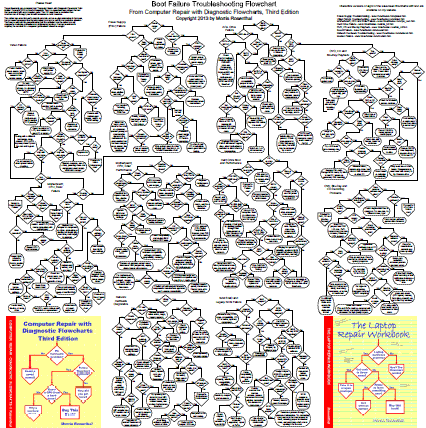 |
- Boot Failure Troubleshooting Poster ( 30" x 30" printable PDF). Zoom to 100% after it opens or you'll barely be able to read it! Poster not for sale, but you are authorized to print a copy for personal or classroom use. To print at full size requires an "E" size plotter or a large copy shop printer. My local copy shop charged $7.00 to print a copy.
Computer Repair with Diagnostic Flowcharts Third Edition: Troubleshooting PC Hardware Problems from Boot Failure to Poor Performance, is not for absolute beginners, as you can see from looking at any of the diagnostic charts. There are no photo-illustrations in the book, no history, nor explanations of basic computer part functions, like "What's a hard drive?" The focus of the book is teaching a structured approach to PC repair. The intended audience is hobbyists who already have some experience repairing computers or beginning computer technicians. The book has been adopted as a class text in several technical colleges and vocational training programs. A free evaluation copy is available to instructors of PC repair courses who can demonstrate they are on the faculty of recognized educational institution in the U.S.The PC diagnostics apply to ATX computers, which displaced the old AT standard beginning in the mid-90's. Although I included a few "live power" troubleshooting procedures for advanced techs with their insurance all paid up, the rule for ATX systems is to unplug the power supply before working in the case. The general approach in the diagnostic flowcharts is to try to push parts swapping off until the end, so that readers without a large stock of spare parts will have a chance to fix the problem without spending money. Flowchart critics please note that my main design approach was to avoid crossed lines, which I believe make flowcharts useless.
| Computer Hardware Repair & Diagnostic Flowchart | |
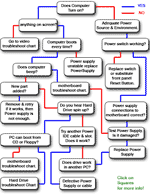 | => My Computer won't even turn on when I press the start button!=> PC turns on but shuts down right away, or stays on but nothing happens.=> My computer turns on but fails the POST (Power On Self Test).=> Unstable Power Supply .& more...Computer Repair Flowchart |
| Hard Drives & Partitions Errors Troubleshoot Flowchart | |
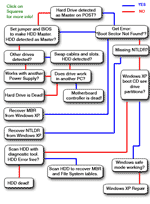 | => No System Disk Found or Boot Partition Errors!=> Boot Sector Not Found.=> NTLDR is Missing.=> Bad Sectors.& more...Hard Drive Troubleshoot Flowchart |
| Motherboard Troubleshoot & Diagnostic Flowchart | |
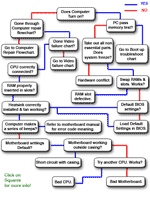 | => Defective RAM.=> Burned CPU.=> Hardware Conflict.=> Bad Adapters.& more...Motherboard Troubleshoot Flowchart |
| Video Card Troubleshoot Flowchart | |
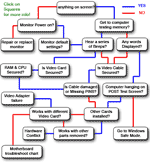 | => Nothing on the screen.=> Wrong Settings, hardware conflicts.=> Faulty cables.=> Windows loads only in safe mode& more...Video card Troubleshoot Flowchart |
| Data Recovery | |
 | => I NEED to Save / Recover my Data!=> Erased Partition & Data.=> Hard Drive not spinning up data recovery.Go to Data Recovery |
| Windows XP Reset | |
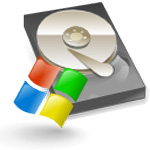 |
=> No POST (Power On Self Test) error, but my computer won't boot Windows XP
|
| Virus, Trojans & other Malwares | |
 |
=> Free Antivirus Scan.
|
| Not Sure what the problem is, need a Systematic Hardware Test! | |
 |
=> My computer is giving me Errors and crashes not sure why, I need to start with a
|
Computer Repair Flowchart.
(Computer Repair Tricks, made as easy as 1, 2, 3, computer fixed!)
Welcome to Fixing my computer, theAbsolutely FREE computer repair guide. This site navigates you through a computer repair flowchart with one question at a time.
Fixing my Computer is designed to be as easy and complete as possible. It has two main (interconnected) sections:
Hardware problems (failure) andsoftware problems (including fixing devices & peripherals).
Follow the steps systematically to repair your computer specially in the Hardware section as SAFETY might become an issue.
Fixing my Computer is best suited for Personal Computers (PC) usingWindows Xp. Other computers can also be repaired using this site as a general guide. I do however recommend that you read your user manual first in order to be aware of your hardware specifications.
Fixing my Computer is designed to be as easy and complete as possible. It has two main (interconnected) sections:
Hardware problems (failure) andsoftware problems (including fixing devices & peripherals).
Follow the steps systematically to repair your computer specially in the Hardware section as SAFETY might become an issue.
Fixing my Computer is best suited for Personal Computers (PC) usingWindows Xp. Other computers can also be repaired using this site as a general guide. I do however recommend that you read your user manual first in order to be aware of your hardware specifications.
Can it fix my
computer?
(If nothing is damaged then most probably your computer can be repaired!)
Here are a few of the problems that can be fixed with the computer repair flowchart:
> blue screen problems.
> overheating & cooling solutions.
> OS locked up, password recovery.
> Unbootable systems.
> PC won't start at all.
> Keeps shuting down.
> not responding at all.
> Computer is freezing.
> Virus, worm, spyware, trojans,...
> Boot partition issues.
> Computer hanging & freezing.
> Windows Xp Troubleshoot.
> Devices not found.
> blue screen problems.
> overheating & cooling solutions.
> OS locked up, password recovery.
> Unbootable systems.
> PC won't start at all.
> Keeps shuting down.
> not responding at all.
> Computer is freezing.
> Virus, worm, spyware, trojans,...
> Boot partition issues.
> Computer hanging & freezing.
> Windows Xp Troubleshoot.
> Devices not found.
and much more...
Learn about your computer and save money by repairing it yourself!
Repairing a computer is not that technical when you know what the parts do. At first, you'll always need someone with more experience with PC to ask the questions that are tricky. But the most important thing is to learn where to find the right information. The good thing is that you have already started that process and you are already one step closer to get your computer repaired yourself!
Put Safety FIRST always (even when fixing your PC).
Repairing a computer is rather very safe. The only High Voltages is found in the power supply. There are few rules to adhere to, the first one being to use common sense. Make sure you follow this Computer repair guide thoroughly, in order to protect your safety, and hardware parts. The first step is a quick safety review specialized for computer repairs. Do not skip it! It might cost you your health or your computer (or both).






No comments:
Post a Comment